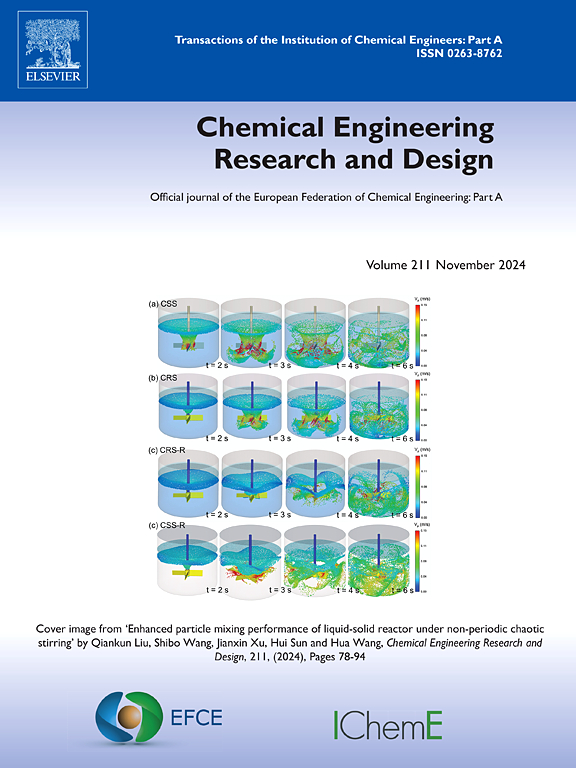Study of flow characteristics in straight-flow gas-liquid cyclone separator
IF 3.7
3区 工程技术
Q2 ENGINEERING, CHEMICAL
引用次数: 0
Abstract
In recent years, the rapid development of the natural gas industry has put forward higher requirements for gas-liquid cyclone separation technology. However, the separation effect of conventional straight-flow gas-liquid cyclone separator on small-size droplets remains unsatisfactory, and the pressure drop is relatively high. In order to improve the comprehensive performance of cyclone, numerical simulation study was carried out to analyze the distribution of the flow field, droplet particles and liquid film, as well as to investigate the influence of various factors on the flow field and separation performance. The results show that the tangential velocity distribution conforms to the Rankine vortex structure, the local vortex predominantly exists in the bottom center of the cylinder and the exhaust pipe. The liquid droplets are mostly distributed in the free vortex region, and as the flow progresses, the number and sizes of particles gradually decrease, most particles in the exhaust pipe have a particle size of less than 2 μm, indicating that the cyclone is effective in separating small-size droplets, and the liquid film is mainly distributed in the lower part of the cylinder, extending upwards along the helix. Increasing the intake can effectively improve the separation efficiency, within the range of intake from 60 m3·h−1 to 100 m3·h−1, the best separation efficiency—reaching up to 97.5 %—is achieved when the height of the cylinder is 350 mm, the number of blades is 10, the angle of the blade outlet is 25°, and the structure of the exhaust pipe is a straight cylinder with a conical shape, while at the same time generating low energy consumption and a relatively large quality factor indicating excellent overall performance of the cyclone. The results of this study can provide a certain reference value for the optimization design of straight-flow gas-liquid cyclone separator.
直流式气液旋风分离器流动特性研究
近年来,天然气工业的快速发展对气液旋流分离技术提出了更高的要求。但传统的直流式气液旋风分离器对小粒径液滴的分离效果仍不理想,且压降较高。为了提高旋流器的综合性能,进行了数值模拟研究,分析了旋流器流场、液滴颗粒和液膜的分布,考察了各种因素对旋流器流场和分离性能的影响。结果表明:切向速度分布符合朗肯涡结构,局部涡主要存在于气缸底部中心和排气管;液滴主要分布在自由涡区,随着流动的进行,颗粒的数量和尺寸逐渐减小,排气管中的颗粒大多粒径小于2 μm,说明旋风分离器对小粒径液滴的分离是有效的,液膜主要分布在气缸下部,沿螺旋向上延伸。增加进气可有效提高分离效率,在60 m3·h−1 ~ 100 m3·h−1的进气范围内,当气缸高度为350 mm,叶片数为10,叶片出口角度为25°,排气管结构为直筒锥形时,分离效率最高,可达97.5 %。同时产生较低的能耗和相对较大的质量因数,表明旋风分离器的整体性能优良。研究结果可为直流式气液旋风分离器的优化设计提供一定的参考价值。
本文章由计算机程序翻译,如有差异,请以英文原文为准。
求助全文
约1分钟内获得全文
求助全文
来源期刊

Chemical Engineering Research & Design
工程技术-工程:化工
CiteScore
6.10
自引率
7.70%
发文量
623
审稿时长
42 days
期刊介绍:
ChERD aims to be the principal international journal for publication of high quality, original papers in chemical engineering.
Papers showing how research results can be used in chemical engineering design, and accounts of experimental or theoretical research work bringing new perspectives to established principles, highlighting unsolved problems or indicating directions for future research, are particularly welcome. Contributions that deal with new developments in plant or processes and that can be given quantitative expression are encouraged. The journal is especially interested in papers that extend the boundaries of traditional chemical engineering.
 求助内容:
求助内容: 应助结果提醒方式:
应助结果提醒方式:


